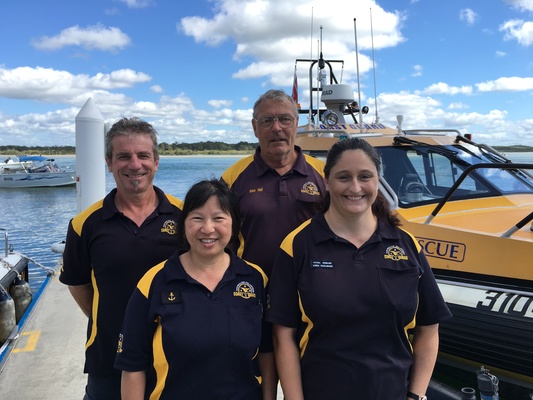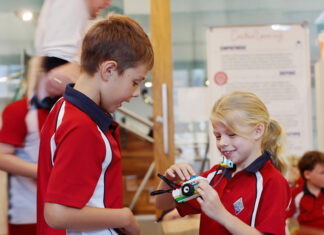By RON LANE
IT WAS an open day at the Noosa Coast Guard – a day when the general public is invited in to meet the team and have an escorted walk around the premises.
Also, it gives them the opportunity to have a close look at the boats that patrol our waters.
However for Coast Guard Commander Alan Hall it soon turned into a day that was to leave this veteran of 15 years somewhat flabbergasted and disappointed.
The cause of this was that after talking to them and answering their questions he came to realise, that for many of these people, despite having lived on the coast for years, they were totally ignorant of not only the purpose of the Coast Guard, but above all just who they were.
“I just could not believe it,” he said, ‘“but some people actually thought that we were in fact lifesavers and belonged to the club down the beach. We may laugh about it but now in fact it is really very sad.’’
Despite experiencing this sort of attitude, Alan does not let it get at him, for he is still as dedicated as ever. What a lot of people don’t know is that Noosa has a great team of 105 dedicated voluntary members, of which some 15 per cent are women.
For 71-year-old Alan, his love of the sea and boats started back in his home town Edgware Middlesex England.
“After leaving high school I started in the workforce as an apprentice plumber, and after my apprenticeship I became self-employed. I did this for several years and then moved on to running a fishing charter boat in the Thames Estuary, a business I was to run for the next four years.’’
It was during this time that Alan, when on a blind date arranged by some friends, met an attractive young hairdresser named Susan; a friendship started and in 1965 they married. Now they are the very proud parents of three boys.
For Alan and Susan their first contact with Australia came in 1980 when on a holiday they visited Alan’s sister who had migrated in 1970.
Such was their impression of Australia that on returning to England they decided that they too would migrate; one year later they were back in Australia; this time for good.
On their arrival in Australia they settled in Baulkham Hills Sydney where they were to live for the next 20 years.
‘“Our love affair with Noosa started in 1981 when we visited while on holidays. We loved the place and always wanted to come back, but we realised that work was really hard to get. After reaching retirement we decided to sell up and in 2001 we made the shift to Noosa. The thing that attracted us to Australia and in particular Noosa, was the fact that after England everything was so colorful; in particular Noosa.
Alan did not hesitate. Immediately on arrival and after a discussion with his wife, he joined the Coast Guard.
“Settling in was easy. They were a great team and they made me feel at ease.
I immediately started doing my basic training which would took me to competent crew member.
“This course takes six months; and during this time we are referred to as back deck operators. After this I continued other advanced training. As a result of these courses I eventually reached skipper grading; first level was restricted, then offshore and finally the rank of unrestricted skipper.
“Speaking about our patrol work we can go to sea with a crew of three but normally it is four.
“All crewies are fully qualified; and of course this training includes radio and first aid. Being a member of such a volunteer organisation gives us something of which we can be very proud.
“The dedication of the Noosa coast guard members is very high.”
Because the coast guard and the surf lifesaving members of the Jet Boat Rescue Service are basically doing the same work, their paths often cross and on many occasions when search and rescue situations arise, they do in fact work in close harmony.
“One thing that I have always enjoyed was our friendship with the lifesavers of the Jet Boat Service. Often when having a break during patrol they would call in at our base and we would all join in for a coffee.
“We got to know each other and the relationship was great. Then we were informed that the service was being transferred to another area of patrol and we were very disappointed and I must say a bit mystified. We were really sad to see them go.”
The work load for Alan and his people is virtually 24/7, seven days a week. On weekends and public holidays the observation tower situated at the mouth of the Noosa Bar, is also manned by radio operators.
For Alan and all members at administration level, perhaps the major concern is and always
will be finance.
“To run our station would cost us in the vicinity of $200,000 a year of which we have to raise $150,000 ourselves and the rest comes through government assistance.
“The big expense is of course our patrol boats but naturally we don’t have to change them every year.
“To replace one of our big boats, say a 10.23-metre mono hull, we could be up for something like $1.2 million, the next size down would cost $500,000, and the smallest in the fleet $100,000. The life of the big boats with top-class maintenance could stretch out to 20 years.
When we discussed the public concept of the Coast Guard organisation, it became obvious that here was a subject that was indeed a problem.
“Sometimes you get the feeling that we are indeed the forgotten service; the only time they think about us is when they are out at sea and something goes wrong. As I said before some people even think that we are just a part of the lifesaving club. Incredible!”
What the general public doesn’t realise is that in a busy year they can get anything up to 180 boat rescues and 35 boat rollovers in the Noosa Bar.
“When we tally the number of people involved in these dangerous situations,” said Allen, “boat crews, families, tourists, fisherman, our tally for a year’s rescue work has touched a total of 800 lives that have been placed in jeopardy during these operations.”
It was just on 8am on the first Saturday in October 1984, and the newly opened three-tower system, located on Noosa beach had been operational for approximately a total of 30 minutes.
With tower number one being front of the surf club, two at the rock wall and three (the tower manned by Coast Guard) at the mouth of Noosa Bar, the entire beach plus the bar was under total observation.
However because of the length of the rock wall, a blind spot was created at the left corner of the middle tower. Fortunately this area could be covered by cross vision by the Coast Guard. At 8.05 the guard tower raised the alarm, three men in big trouble. One man was swept out and two others had gone to his assistance; all unobserved by the middle tower, because of the blind
spot. On receiving the Coast Guard alarm a boat team was dispatched, and in big surf the three men were rescued.
As a result of the team work of the Coast Guard and lifesavers, an incident that would be repeated many times over in the years ahead, had been responsible for the saving of the men; ironically an old grandfather and his two young grandsons. A massive family tragedy avoided.
When this incident was related to Alan he again mentioned their relationship with the jet boat crews. One of his fondest memories was being able to create a great friendship with these men. “Two teams doing the same job,” he said.
For Alan, who has for 15 years quietly gone about his job, moved up through the ranks from back deck operator to commander, you are not the forgotten service; for you and your team, are all our people.







